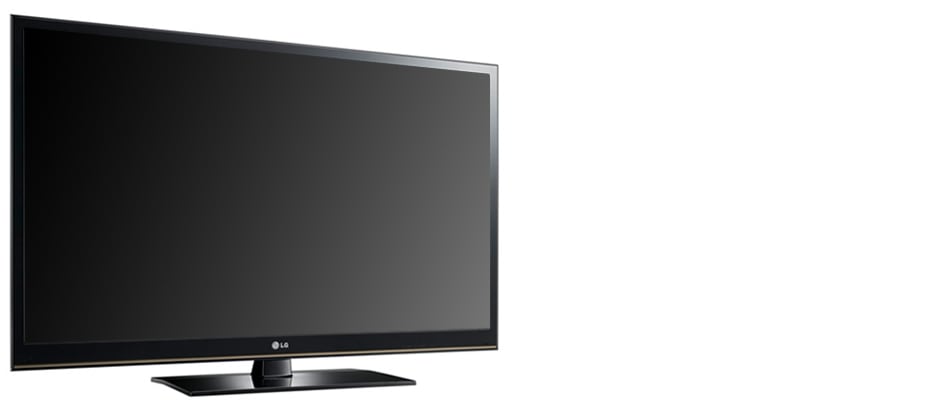Pros
Cons
Introduction
Overall Design
{{section_header}}{{section.name}}{{/section_header}}
The {{product.name}} has a standard appearance, by TV standards. A thick bezel surrounds all four sides. Along the bottom there's a reflective strip with a screen tone pattern. It's questionable gilding on a rather drab lily, but we suppose it's nice that they're trying.
Front
{{section_header}}{{section.name}}{{/section_header}}

Back
{{section_header}}{{section.name}}{{/section_header}}

Sides
{{section_header}}{{section.name}}{{/section_header}}

Stand/Mount
{{section_header}}{{section.name}}{{/section_header}}
The stand is quite sturdy, connected with four very long screws to the TV panel.

Controls
{{section_header}}{{section.name}}{{/section_header}}
The {{product.name}} has a strip of touch-sensitive controls that run along the bottom of the bezel. Controls like these tend to leave messy fingerprints and they're hard to find in the dark.

Remote Control
{{section_header}}{{section.name}}{{/section_header}}
The remote control that ships with the {{product.name}} is similar to the remote that comes with many other LG TVs, and yet of a lesser quality. In fact, there are a lot small but puzzling discrepancies between this entry-level plasma and the LK330, the entry-level LCD we just reviewed. The LK330 has beautiful menus and a high-quality remote made from excellent materials. The PT350 has what looks like a cheaper duplicate of that menu and a remote that seems identical, but on closer inspection is made from uglier materials. It works about as well, but it just doesn't look as good.

In the Box
{{section_header}}{{section.name}}{{/section_header}}
The {{product.name}} ships with the stand & necessary screws, remote control & batteries, a shortened instruction manual, and assorted documentation.
Black Level
{{section_header}}{{section.name}}{{/section_header}}
The {{product.name}} has a black level of 0.12 cd/m2. As you can see in the chart below, this is identical to the black level of the next-step-up LG plasma, the PV450. However, comparably priced Panasonic and Samsung plasmas had much deeper blacks. More on how we test black level.
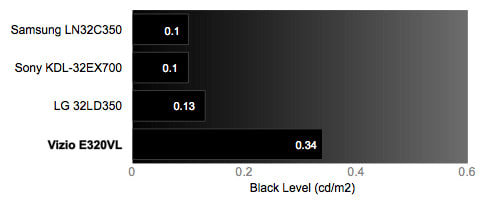
Peak Brightness
{{section_header}}{{section.name}}{{/section_header}}
The {{product.name}} eked out a peak brightness of 89.25 cd/m2. That's rather dim, and it may have trouble competing with the ambient light of a sunny room. Any LCD television would blow these numbers out of the water. In our little comparison pool in the chart below, the Panasonic and the Samsung are also dim, but significantly better than the LGs. More on how we test peak brightness.
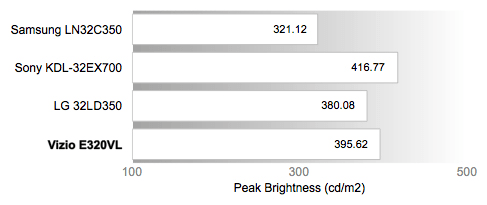
Contrast
{{section_header}}{{section.name}}{{/section_header}}
A 774:1 contrast ratio is unimpressive, and that's exactly what the {{product.name}} delivered. Throwing money at a better LG won't solve the problem either, because LG's PV450 series scored the same. What does this mean for you, the TV viewing? A shallow contrast ratio doesn't necessarily meant it's a bad picture. But if you put it next to a better TV, you would notice how shallow the shadows are and how dim the brights are. The human eye is very sensitive to contrast. If you're used to watching a TV with decent contrast ratio, the {{product.name}} will probably come as a disappointment. More on how we test contrast.

Tunnel Contrast
{{section_header}}{{section.name}}{{/section_header}}
Like many plasma TVs, if you display a huge patch of black, the black level will be much darker than if you displayed a tiny patch of black surrounded by bright white. I.e., the shadows of a cave would be nice and dark if you were shooting from within the cave. If you shot the mouth of the cave surrounded by white snow, the cave would look brighter. This is one of the weaknesses of a plasma TV that LCD owners never have to worry about. More on how we test tunnel contrast.
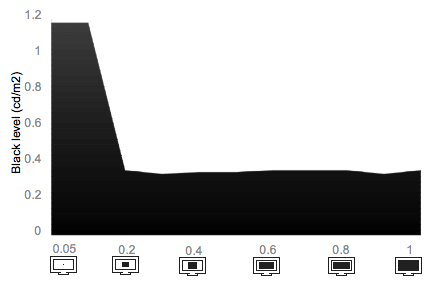
White Falloff
{{section_header}}{{section.name}}{{/section_header}}
Plasmas also have a hard time maintaining consistent white levels. A huge patch of white will appear dimmer than a small patch of white. More on how we test white falloff.
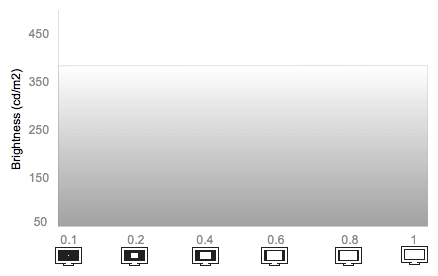
Uniformity
Greyscale Gamma
{{section_header}}{{section.name}}{{/section_header}}
The greyscale gamma test measures how well TV transitions from black to white within the greyscale. What we're looking for in the chart below is a smooth line that curves steadily upward, with an ideal slope between 2.1 and 2.2.
The {{product.name}} did fairly well. That first stretch of the response curve, in the lower left, indicates the shadow details. It's a little flat for the first portion, which indicates that the the TV has a hard time displaying some of the deepest blacks. The line then climbs steadily upward until it starts to go flat again at the far right, which indicates the highlights.
Overall, this is a decent performance. The slope is a little steep, which means that it might be missing some of the finer gradations. Also, any little kinks and hiccups in the response curve indicate that the {{product.name}} might produce some banding rather than a smooth gradient. More on how we test greyscale gamma.
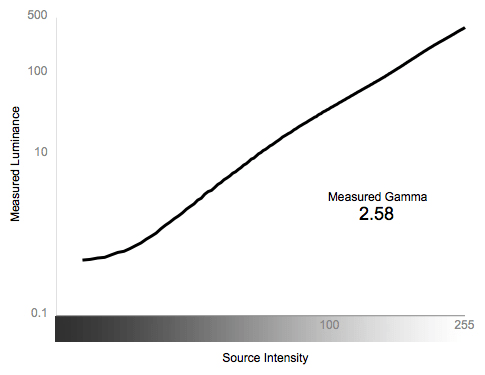
Color Temperature
{{section_header}}{{section.name}}{{/section_header}}
The {{product.name}} didn't produce a perfectly even color temperature, but we've certainly seen worse. As you can see in the chart below, as the signal intensity changes, the color temperature wavers from warm to cool and back again many time. The variance, however, is rather small. More on how we test color temperature.

RGB Curves
{{section_header}}{{section.name}}{{/section_header}}
We were pleasantly surprised to see that this entry-level plasma TV from LG scored better than some of the best LG plasmas. For some reason, most of the LG plasmas we reviewed this year showed a dramatically uneven RGB response curve, wherein there was a sharp spike in luminance halfway through the signal range (clearly evident on the LG 50LV450). No such problems here.
As you can see in the chart, there are a few wobbles that indicates areas where you might see some color banding. On the whole, though, the problems are minor. More on how we test RGB curves.

The color strips below are digital recreations of the results from the RGB Curves test, compared against three similar TVs as well as an ideal response curve.
Motion Performance
{{section_header}}{{section.name}}{{/section_header}}
The {{product.name}}'s motion test performance was marked by a lot of errors. Images with fine details, like faces or smooth color gradients, became garbled with ugly color banding and fuzzy mosquito noise. High contrast images wobbled and distorted, leaving color trails. It was a mess. It's hard to tell which problems were caused by the pixel response time and processing, and which were caused by problems with the resolution scaling, discussed further down this page. More on how we test motion performance.
3:2 Pulldown & 24fps
{{section_header}}{{section.name}}{{/section_header}}
The {{product.name}} has few problems displaying native 24fps, like you might get with Blu-Ray movies. There was a little judder when viewing scenes with slow, horizontal pans, but nothing notably bad. More on how we test 3:2 pulldown and 24fps.
Resolution Scaling
{{section_header}}{{section.name}}{{/section_header}}
The {{product.name}} has an unusual native resolution of 1024 x 768. This is not a common TV resolution. In fact, it's far more common on computer monitors, so it's possible that LG's factory had some overstock in one division, so they just pawned it off on the TV manufacturing division.
The problem is that there's no 1024 x 768 video broadcast. Everything you TV signal you feed it has to be re-sized to fit the screen, and the {{product.name}} does a very poor job of it. Fine details, like small text, are frequently unintelligible. Moires appear in areas of high-frequency patterns (like certain clothing fabrics). More on how we test resolution scaling.
480p
The 480p signal we sent the {{product.name}} lost 1% of the image on all sides due to overscan. There was also noticeable Moire in certain patterns. It's unusual that a TV chokes on 480p.
720p
The 720p test patterns also showed significant Moireing in high contrast / high frequency patterns.
1080p
The 1080p patterns were the biggest problem. Small text was completely illegible.
Formats
{{section_header}}{{section.name}}{{/section_header}}
The {{product.name}} has a native resolution of 1024 x 768, which does not conform to any NTSC broadcast format. While the TV can definitely handle NTSC signals, everything has to be shrunk to fit the screen, which created some problems with picture sharpness.
Viewing Angle
{{section_header}}{{section.name}}{{/section_header}}
The {{product.name}} produced a wide viewing angle of 78 degrees in either side from center, for a total viewing angle of 156 degrees. That should mean everyone is your ultra-wide rec room will get the same color and contrast performance as the person sitting dead-center. LCD TVs can't come close to this kind of viewing angle.

Reflectance
{{section_header}}{{section.name}}{{/section_header}}
While plasmas enjoy a wide viewing angle, they often suffer from a reflective screen that can cause problems in a sunny room. Plasmas have glass in the front, unlike the plastic in LCDs. More expensive plasmas often benefit from anti-reflective technology that tries to minimize the problem, but we're not seeing much evidence of that here. When hit with a strong ambient light, there's a huge glare on the {{product.name}}'s screen that significantly reduces the already weak contrast ratio.
Video Processing
{{section_header}}{{section.name}}{{/section_header}}
The {{product.name}} has a number of video processing features, but few if any make for a better picture.
Calibration
{{section_header}}{{section.name}}{{/section_header}}
The {{product.name}} is very simple to calibrate for best color performance. Simply put it in Cinema mode and make the tweaks we recommend in the table below. Once in Cinema mode, most of the unhelpful video processing features are disabled.

All of our calibration is done in conjunction with the DisplayMate software.
](http://www.displaymate.com/)
Video Modes
{{section_header}}{{section.name}}{{/section_header}}
The {{product.name}} has a number of video modes for simple, one-touch changes to picture quality.
Connectivity
{{section_header}}{{section.name}}{{/section_header}}
The {{product.name}} has a number of ports located on the back of the TV. The whole jack pack feels a little loose in the TV's cavity, because whenever you plug something in, the entire circuit board tucks back into the panel like it's trying to avoid a poke.

In addition to the expected AV inputs, the {{product.name}} has a USB port on the side for connecting to USB mass storage devices, as well as an RS-232C port and a wired remote port. As these last two are directed at high-end enthusiasts, we're wondering what they're doing on an entry-level TV.
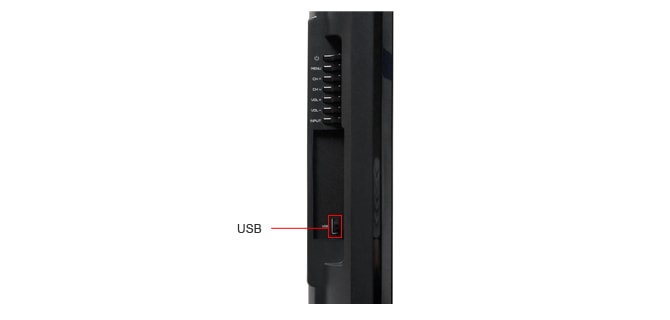
Placement
{{section_header}}{{section.name}}{{/section_header}}
The port placement on the {{product.name}} is great. Most of the ports are on the back, well-labeled and easy enough to reach. More ports, including an HDMI, composite AV input, and USB port are located on the side for faster access.
Audio Quality
{{section_header}}{{section.name}}{{/section_header}}
The {{product.name}} offers two 10W speakers, which can't provide much power or bass response, but do the best they can considering their limitations. The audio was fairly crisp. The surround sound emulator even worked (kind of). If you positioned yourself directly in front of the TV and enabled it, the sound did seem to come from speakers that were slightly farther apart.
Menu Interface
{{section_header}}{{section.name}}{{/section_header}}
Having just wrapped up the review for LG's entry-level LCD television, the LK330, we assumed things would be similar with the entry-level plasma. We really liked the LK330's menu, which was mostly identical to the top-of-the-line LG LCD. What we actually got on the PT350 was something very close, yet uncannily removed. It was almost like someone had copied the menus from the LCD line and made a cheap copy of them. All the submenus were the same, and arranged in roughly the same way, but all the graphics were a little off looking by comparison, stripped of the finishing touches like color gradients and nicer fonts.

The whole experience was different, too, because the response time was much slower on the PT350. All in all, it's a fine menu. If you never see the "better" version on their LCD TVs, you'll never even know what you're missing.

Instruction Manual
{{section_header}}{{section.name}}{{/section_header}}
The LG instruction manuals are frustrating and terrible. There's no other way to properly describe them. Each manual they bother to produce covers about 40-50 different models. But because each series has a slightly different assembly process, or different menu options, or different connectivity options, there are all sorts of little notes and footnotes indicating which series has which. LG, would it kill you to make a few more unique manuals? Do your customers a favor!

A manual for so many TV models, they have to be further categorized by type.
Local Media Playback
{{section_header}}{{section.name}}{{/section_header}}
On the side of the {{product.name}} is a USB port that can connect to USB mass storage devices like thumb drives. As soon as you plug one in, the TV asks if you'd like to access the contents. Say yes, and then it will ask you to choose between viewing photos (JPEG only) or audio files (MP3 only). It cannot play any other type of file, including video files.
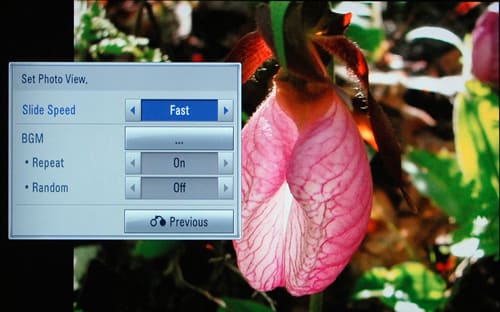
The {{product.name}} allows you to create slideshows and playlists. The interface is rudimentary but effective enough.
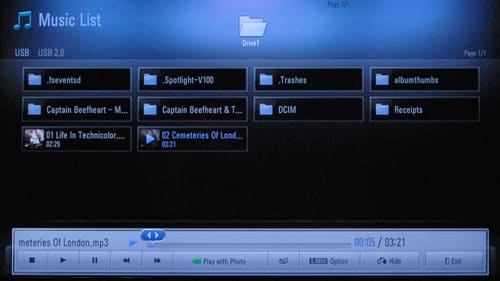
Power Consumption
{{section_header}}{{section.name}}{{/section_header}}
The {{product.name}} requires little power, compared to similar plasma TVs. In our tests, it drew an average of 121 watts, which would cost around $23.69 per year on your electric bill.
The chart below can be a little misleading because screen size it one of the most important factors in power consumption, and the Samsung D450 and LG PV450 are 50+ inch screens.
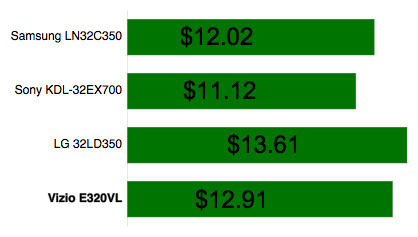
Value Comparison
{{section_header}}{{section.name}}{{/section_header}}
The LG PV450 series is the next step up from the PT350 series. There's no 42-inch version, but for comparison's sake, the 50-inch version of the PV450 is $150 more than the 50-inch PT350. For that money, you get a much better native resolution of 1080p. However, most of the core performance issues were a draw, or perhaps even favoring the cheaper PT350. We found serious issues with the PV450's color and motion performance. Save your money.
Blacks & Whites
{{section_header}}{{section.name}}{{/section_header}}
The black level, peak brightness, and contrast ratio were nearly identical between models.

Color Accuracy
{{section_header}}{{section.name}}{{/section_header}}
The more expensive PV450 series exhibited serious color performance issues that plagued many of the LG plasmas we tested this year. For whatever blessed reason, the PT350 was spared, and scored better in these tests.
Motion
{{section_header}}{{section.name}}{{/section_header}}
The PV450 series showed real problem in the motion tests. While the PT350 was far from perfect, it appears to have fared better.
Viewing Effects
{{section_header}}{{section.name}}{{/section_header}}
Both TVs are plasmas, so both have great viewing angles. The PT350 proved to be a little wider than the PV450, but you probably wouldn't notice the difference in your own home.
Connectivity
{{section_header}}{{section.name}}{{/section_header}}
There is no difference in the number of ports.
Value Comparison
{{section_header}}{{section.name}}{{/section_header}}
The Panasonic TC-P42X3 ($599 MSRP) retails for exactly the same as the {{product.name}}, and it's the same screen size, and a plasma TV, making this a real showdown. Our testing reveals that it had certain strengths over the {{product.name}} – such as contrast ratio and motion performance – while the color performance was worse, and it offers fewer ports. The major step-up feature on the Panasonic X3, however, is internet connectivity. It comes per-loaded with Netflix, Amazon, Pandora, and many more apps, with the ability to download more. That alone makes it a more intriguing television. Seeing as the performance is a draw between the two, we'd choose the one with more features. Panasonic it is.
Blacks & Whites
{{section_header}}{{section.name}}{{/section_header}}
The Panasonic X3's black level was significantly deeper than the {{product.name}}, and the whites were brighter. You'd better believe that makes for a wider contrast ratio.

Color Accuracy
{{section_header}}{{section.name}}{{/section_header}}
The Panasonic showed the effects of some unusual and unfortunate processing that caused the luminance levels to spike halfway through the signal range. As you can see in the strips below, it causes a hard, visually-evident break between "dark colors" and "light colors" rather than a smooth transition.
Motion
{{section_header}}{{section.name}}{{/section_header}}
The {{product.name}} had a lot of problems in our motion testing. The Panasonic X3 had far fewer.
Viewing Effects
{{section_header}}{{section.name}}{{/section_header}}
Both the Panasonic X3 and the {{product.name}} are plasma TVs, so both have viewing angles that are plenty wide enough.
Connectivity
{{section_header}}{{section.name}}{{/section_header}}
The Panasonic X3 has fewer video inputs, but it does allow you to connect to streaming content applications like Netflix.
Value Comparison
{{section_header}}{{section.name}}{{/section_header}}
The Samsung PN51D450, the model we reviewed, retails for $799 (MSRP), but there's a 43-inch version for $549 (MSRP) – that's $50 less than the {{product.name}}. The Samsung showed resolution scaling problems just as bad as the LG, along with some color performance issues. That said, we were impressed with the black level and contrast ratio. It's not a great TV, but neither is the LG PT350. They're both entry-level slackers that get the job done but don't excel at it. We still prefer the Panasonic X3, one page back.
Blacks & Whites
{{section_header}}{{section.name}}{{/section_header}}
The Samsung D450 has a much deeper black level, by far. As a result, the contrast ratio is more than five times wider.

Color Accuracy
{{section_header}}{{section.name}}{{/section_header}}
The Samsung D450's color channels were a little out of whack, so the reds appear darker than the blues and greens. That's a minor issue, however. The overall performance is about the same as the {{product.name}}.
Motion
{{section_header}}{{section.name}}{{/section_header}}
The Samsung D450 proved much better in our motion tests than the {{product.name}}.
Viewing Effects
{{section_header}}{{section.name}}{{/section_header}}
Both the {{product.name}} and the Samsung D450 are both plasma TVs, so both have very wide viewing angles.
Connectivity
{{section_header}}{{section.name}}{{/section_header}}
As an entry-level series, the Samsung D450 does not offer a whole lot of ports. In fact, there are far fewer than the {{product.name}}.
Conclusion
The {{product.name}} ($599 MSRP) is a better entry-level TV than others we have seen. This plasma TV has a reasonable price matched with a reasonable performance in many areas. The color scores were good and there are a number of useful connectivity options to satisfy all types of users, even high-end enthusiasts.
However, we cannot overlook a number of shortcomings that seriously dampen our good feelings towards the TV. The most significant issue is the 1024 x 768 native resolution. As it does not match any standard TV broadcast, everything must be re-sized to fit the screen, which created a number of sharpness problems. The motion performance, too, is inadequate. Even the black level, something that plasmas should have no trouble excelling at, was far less impressive than entry-level plasmas from Samsung and Panasonic.
Overall, the {{product.name}} is only a bargain if you're not too picky about image quality. Sure, it will absolutely do the job, and there are always trade-offs with an entry-level TV. If you have an open field and a limited budget, though, be sure to check out the Panasonic X3 series before you buy anything.
Model Series Comparison
{{section_header}}{{section.name}}{{/section_header}}
Both models in the PT350 series share the ill-fitting 1024 x 768 resolution. If the sharpness problems looked this grave on the 42-inch we reviewed, we can't image how they'll look when they're scaled up on the 50-inch version. There are very few differences between these two. This entry-level plasma series is surprisingly well-equipped with ports, if nothing else.
Photo Gallery
{{photo_gallery "Front Tour Image", "Back Tour Image", "Sides Tour Image", "Stand Photo", "Controls Photo", "Remote Control Photo", "Connectivity Tour Image 1", "Connectivity Tour Image 2", "Connectivity Extra Photo", "Menu Main Photo", "Menu 2 Photo", "Internet Features 1 Photo", "Internet Features 2 Photo", "Internet Features 3 Photo", "Local Media Playback 1 Photo", "Local Media Playback 2 Photo"}}
Ratings & Specs
{{manufacturer_specs_table}}
Meet the tester
David Kender oversees content at Reviewed as the Editor in Chief. He served as managing editor and editor in chief of Reviewed's ancestor, CamcorderInfo.com, helping to grow the company from a tiny staff to one of the most influential online review resources. In his time at Reviewed, David has helped to launch over 100 product categories and written too many articles to count.
Checking our work.
Our team is here to help you buy the best stuff and love what you own. Our writers, editors, and experts obsess over the products we cover to make sure you're confident and satisfied. Have a different opinion about something we recommend? Email us and we'll compare notes.
Shoot us an email